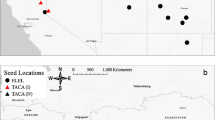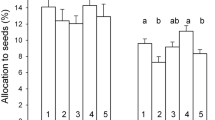Abstract
To better understand the ecological and evolutionary processes that underlie the ability of invasive plants to colonize and spread in a region, basic data on quantitative genetic variation in growth and reproduction of plants from contrasting microsites are desirable. The annual grass Microstegium vimineum is an invasive colonizer of the herbaceous layer in forests of the eastern United States. This greenhouse study utilized seeds collected from maternal plants in a shady forest or sunny edge microsite in central New Jersey, USA, to examine variation in growth trajectories and size-dependent reproduction. Questions addressed were (1) do growth trajectories vary significantly among families and between microsites? and (2) does reproductive mass scale with vegetative size? The trajectory for shoot dry mass over time was significantly related to microsite, due apparently to greater growth over the final 8 weeks of plants from the interior compared to those from the edge. It is suggested that a growth increase late in the season enables plants to maximize reproduction when light conditions improve following canopy leaf senescence. Number of tillers exhibited significant variation among families within microsites, but growth trajectories did not. Positive phenotypic and genetic correlations were detected between reproductive and vegetative mass per tiller; thus selection may favor large tillers to increase seed output, a critical life history trait for an invasive weed.



Similar content being viewed by others
Abbreviations
- DRN:
-
Developmental reaction norm
References
Baker HG (1965) Characteristics and modes of origin of weeds. In: Baker HG, Stebbins GL (eds) The genetics of colonizing species. Academic Press, New York, pp 147–169
Barden LS (1987) Invasion of Microstegium vimineum (Poaceae), an exotic, annual, shade-tolerant, C4 grass, into a North Carolina floodplain. Am Midl Nat 118:40–45
Belote RT, Weltzin JF (2006) Interactions between two co-dominant, invasive plants in the understory of a temperate deciduous forest. Biol Invasions 8:1629–1641
Callaway RM, Miao SL, Guo Q (2006) Are trans-Pacific invasions the new wave? Biol Invasions 8:1435–1437
Charlesworth D (2003) Effects of inbreeding on the genetic diversity of populations. Philos Trans R Soc Lond B 358:1051–1070
Charlesworth D, Charlesworth B (1995) Quantitative genetics in plants: the effect of the breeding system on genetic variability. Evolution 49:911–920
Cheplick GP (2003) Evolutionary significance of genotypic variation in developmental reaction norms for a perennial grass under competitive stress. Evol Ecol 17:175–196
Cheplick GP (2005a) Biomass partitioning and reproductive allocation in the invasive, cleistogamous grass Microstegium vimineum: Influence of the light environment. J Torrey Bot Soc 132:214–224
Cheplick GP (2005b) The allometry of reproductive allocation. In: Reekie EG, Bazzaz FA (eds) Reproductive allocation in plants. Elsevier Academic Press, Burlington, MA, pp 97–128
Cheplick GP (2006) A modular approach to biomass allocation in an invasive annual (Microstegium vimineum; Poaceae). Am J Bot 93:539–545
Cheplick GP (2007) Plasticity of chasmogamous and cleistogamous reproductive allocation in grasses. In: Columbus JT, Friar EA, Porter JM, Prince LM, Simpson MG (eds) Monocots: comparative biology and evolution-poales. Rancho Santa Ana Botanic Garden, Claremont, CA, pp 57–65
Claridge K, Franklin SB (2002) Compensation and plasticity in an invasive plant species. Biol Invasions 4:339–347
Cole PG, Weltzin JF (2005) Light limitation creates patchy distribution of an invasive grass in eastern deciduous forests. Biol Invasions 7:477–488
Facon B, Genton BJ, Shykoff J, Jarne P, Estoup A, David P (2006) A general eco-evolutionary framework for understanding bioinvasions. Trends Ecol Evol 21:130–135
Gibson DJ, Spyreas G, Benedict J (2002) Life history of Microstegium vimineum (Poaceae), an invasive grass in southern Illinois. J Torrey Bot Soc 129:207–219
Godt MJW, Hamrick JL (1998) Allozyme diversity in the grasses. In: Cheplick GP (eds) Population biology of grasses. Cambridge University Press, Cambridge, pp 11–29
Honu YAK, Gibson DJ (2006) Microhabitat factors and the distribution of exotic species across forest edges in temperate deciduous forest of southern Illinois, USA. J Torrey Bot Soc 133:255–266
Horton JL, Neufeld HS (1998) Photosynthetic responses of Microstegium vimineum (Trin.) A. Camus, a shade-tolerant, C4 grass, to variable light environments. Oecologia 114:11–19
Jolls CL (2003) Populations of and threats to rare plants of the herb layer: more challenges and opportunities for conservation biologists. In: Gilliam FS, Roberts MR (eds) The herbaceous layer in forests of Eastern North America. Oxford University Press, New York, pp 105–159
Lambers H, Poorter H (1992) Inherent variation in growth rate between higher plants: a search for physiological causes and ecological consequences. Adv Ecol Res 23:187–261
Lee CE (2002) Evolutionary genetics of invasive species. Trends Ecol Evol 17:386–391
Leicht SA, Silander Jr JA, Greenwood K (2005) Assessing the competitive ability of Japanese stilt grass, Microstegium vimineum (Trin.) A. Camus. J Torrey Bot Soc 132:573–580
Linhart YB, Grant MC (1996) Evolutionary significance of local genetic differentiation in plants. Annual Rev Ecol Syst 27:237–277
Luken JO (2003) Invasions of forests in the eastern United States. In: Gilliam FS, Roberts MR (eds) The herbaceous layer in forests of Eastern North America. Oxford University Press, New York, pp 283–301
Maron JL, Vilà M, Bommarco R, Elmendorf S, Beardsley P (2004) Rapid evolution of an invasive plant. Ecol Monogr 74:261–280
McDonald RI, Urban DL (2006) Edge effects on species composition and exotic species abundance in the North Carolina Piedmont. Biol Invasions 8:1049–1060
Morrison JA, Lubchansky HA, Mauck KE, McCartney K-M, Dunn B (2007) Ecological comparison of two co-invasive species in eastern deciduous forests: Alliaria petiolata and Microstegium vimineum. J Torrey Bot Soc 134:1–17
Myers JH, Bazely DR (2003) Ecology and control of introduced plants. Cambridge University Press, Cambridge
Oswalt CM, Oswalt SN, Clatterbuck WK (2007) Effects of Microstegium vimineum (Trin.) A. Camus on native woody species density and diversity in a productive mixed-hardwood forest in Tennessee. For Ecol Manage 242:727–732
Pigliucci M, Schlichting CD (1995) Ontogenetic reaction norms in Lobelia siphilitica (Lobeliaceae): response to shading. Ecology 76:2134–2144
Pigliucci M, Schlichting CD, Jones CS, Schwenk K (1996) Developmental reaction norms: the interactions among allometry, ontogeny and plasticity. Plant Species Biol 11:69–85
Pigliucci M, Diiorio P, Schlichting CD (1997) Phenotypic plasticity of growth trajectories in two species of Lobelia in response to nutrient availability. J Ecol 85:265–276
Price SC, Jain SK (1981) Are inbreeders better colonizers? Oecologia 49:283–286
Redman DE (1995) Distribution and habitat types for Nepal Microstegium [Microstegium vimineum (Trin.) Camus] in Maryland and the District of Columbia. Castanea 60:270–275
Roff DA (1996) The evolution of genetic correlations: an analysis of patterns. Evolution 50:1392–1403
Roff DA (2000) Trade-offs between growth and reproduction: an analysis of the quantitative genetic evidence. J Evol Biol 13:434–445
Sakai AK, Allendorf FW, Holt JS, Lodge DM, Molofsky J, With KA, Baughman S, Cabin RJ, Cohen JE, Ellstrand NC, McCauley DE, O’Neil P, Parker IM, Thompson JN, Weller SG (2001) The population biology of invasive species. Annu Rev Ecol Syst 32:305–332
Schlichting CD, Pigliucci M (1998) Phenotypic evolution: a reaction norm perspective. Sinauer Associates, Sunderland, MA
Snell R, Aarssen LW (2005) Life history traits in selfing versus outcrossing annuals: exploring the ‘time-limitation’ hypothesis for the fitness benefit of self-pollination. BMC Ecol 5:1–14
Stearns SC (1992) The evolution of life histories. Oxford University Press, Oxford
Thompson BK, Weiner J, Warwick SI (1991) Size-dependent reproductive output in agricultural weeds. Can J Bot 69:442–446
Underwood AJ (1997) Experiments in ecology. Cambridge University Press, Cambridge
von Ende CN (2001) Repeated-measures analysis: growth and other time-dependent measures. In: Scheiner SM, Gurevitch J (eds) Design and analysis of ecological experiments. Oxford University Press, New York, pp 134–157
Weiner J (2004) Allocation, plasticity and allometry in plants. Perspectives in Plant Ecology, Evolution, and Systematics 6:207–215
Weinig C (2005) Rapid evolutionary responses to selection in heterogeneous environments among agricultural and nonagricultural weeds. International Journal of Plant Sciences 166:641–647
West-Eberhard MJ (2003) Developmental Plasticity and Evolution. Oxford University Press, New York
Author information
Authors and Affiliations
Corresponding author
Rights and permissions
About this article
Cite this article
Cheplick, G.P. Growth trajectories and size-dependent reproduction in the highly invasive grass Microstegium vimineum . Biol Invasions 10, 761–770 (2008). https://doi.org/10.1007/s10530-007-9170-5
Received:
Accepted:
Published:
Issue Date:
DOI: https://doi.org/10.1007/s10530-007-9170-5




